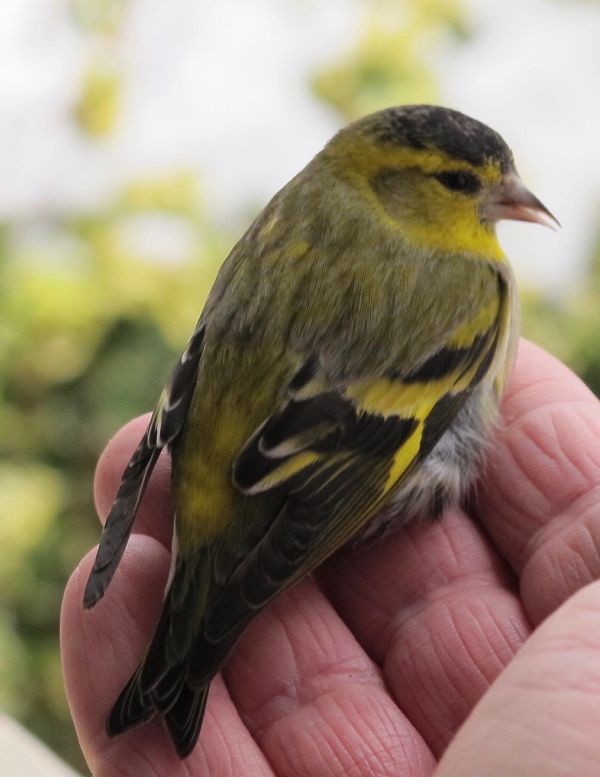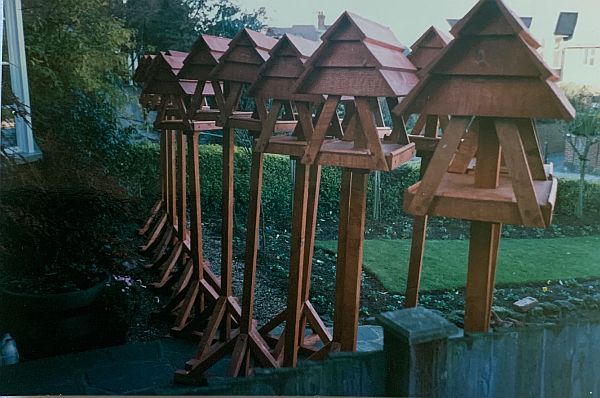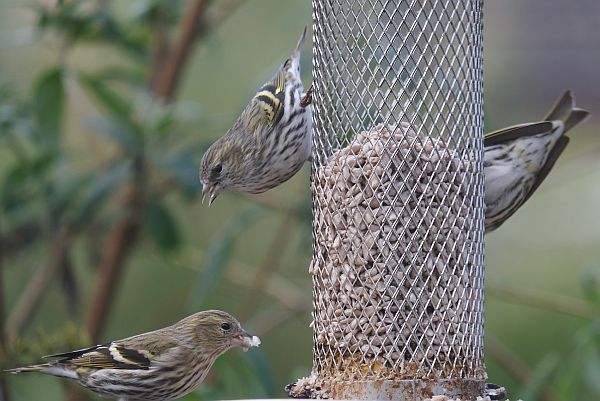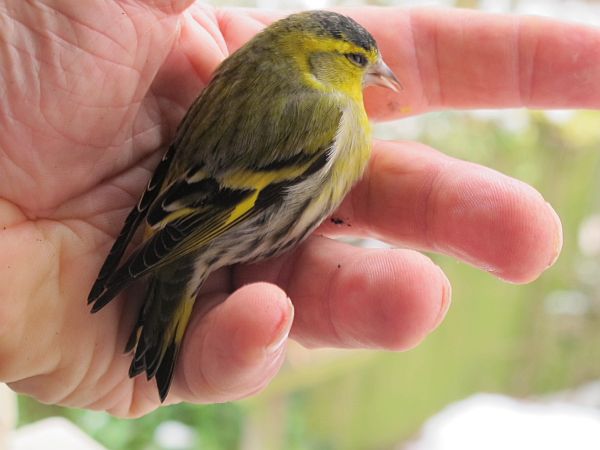Siskin

Siskin.
Bobby’s interest in birds started in Ridge Road Library, North Cheam. One miserable winter, he caught flu quite badly and was off school for a while. Once he started to recover, he revelled in this little, long since gone library. One day he borrowed ‘The Birds of London’. He was amazed by the revelations in this book and by the birds that have been officially recorded within London’s boundaries. Bearing in mind he lived in North Cheam, later a Greater London Borough. The most startling fact of all, and one that has been endlessly repeated given his love of the Pembrokeshire Islands, is this…
A Puffin once landed in the Strand

Ridge Road Library, North Cheam.
He was hooked and wanted to know more. Before he went back to school, he started looking at the birds in the garden. The garden that had just been for football. One day, walking near Boxhill, he ‘saw a Kite’. Then the rarest breeding bird in Britain. Only it wasn’t. It was a Buzzard with central tail feathers missing! Still a rare bird then in Surrey. His interest never took him down the twitcher route. For him, the birds are part of the natural world he loves.
His vision of rare sightings is always accompanied by a sombre thought. Most rarities are lost. For whatever reason they landed up here, they are unlikely to get back to where they came from. For many years an Albatross, a Southern Hemisphere bird, lived with Gannets in Scotland. Marriage and, later, a nice garden in Dorking, really encouraged his interest in garden birds. As a sideline, he made bird tables to sell at his office. In the end, he made 99 before the novelty wore off. £25. Bargain. Not surprisingly, one was in full view of the kitchen window at Saffrons, his home in Dorking.


A consignment of pre-ordered birdtables for the office. About 1980.
And then a revolution started that eventually became the massive bird food industry that exists today. Pet shops and Woolworths started selling peanuts in red net bags. He hung one from the bird table. The birds loved them. Green Finches, Tits. Birds that were agile. The odd Nuthatch joined in.

Red net full of peanuts. Ready to hang in the garden.
Then one cold winter’s day, a new bird turned up on the peanuts. Looking a bit like Greenfinch, it was a lot smaller. Feisty. The female was different to the male. One became six. And, every day, these little birds were back and the Tits and Green Finches seemed to give in to the competition. They stayed all winter and then, one day in May, they just disappeared, And he really missed his first encounter with the Siskin.

Male Siskin.
The next winter, around his birthday time in January, they were back. Staying until May. About this time, living in Saffrons in Dorking, he became friendly with Les. A retired bus conductor, who had become an official bird ringer for the British Trust for Ornithology. His daughter lived two doors down from Bobby, with a much bigger garden.
Each Thursday, Les set up his mist nets in her garden. Bobby used to go round some days. One day, Les caught a Sparrow Hawk. Fantastic bird at close quarters that had put the fear of God into all the other birds who had totally disappeared. Bobby told him how much he loved Siskins. Les told him something that was hard to believe. It was May. Nearly the end of the Siskin’s winter. Any day now they would disappear. The most he ever saw on the peanuts was six. And that exceptional. Les said… “Would you like to know how many Siskins I have ringed this winter?
192
Bobby was flabbergasted. In the years that have followed, he has learned more and more about them. When he moved to Laurel Cottage, we had entered a new age of feeding the birds. The old bird table came with him, but now we had varieties of foods. Big companies sold in bulk and you had proper seed feeders in every shape and size.
Diddley had lived in Laurel Cottage for two years before they met. “Do you get Siskins in the garden?” “What’s that?” If she was to show true love for Bobby, she had to learn fast. Culminating in her own excitement when the Siskins arrived in Laurel Cottage. One year they were late. She said “I reckon they will arrive on your birthday!”. Later, on his birthday morning, she screamed at him to get out of bed for the best of birthday presents.
The Siskins were back.

Not worried about bullies.

Two lads.

Three girls.

Loner? No. Scout.
No one will ever forget 2020. For Bobby, it started badly. The Siskins didn’t come back. No sign on his birthday. February slipped by. So disappointed, he contacted Richard and Giselle on Skokholm, who told him that they had heard from other bird watchers that they hadn’t seen any either. Thought it was the mild winter.
And then they did turn up. In force. Leading to a really sad incident in early May. Bobby had so enjoyed his Breakfast Birdwatch, that he considered feeding the birds through the summer. Normally he stopped until October, expecting them to find their natural food. In anticipation, he had ordered a large 20Kg sack of Sunflower Hearts from Haith’s, his favourite suppliers.
It arrived loose, in a FedEx plastic bag with the label torn off Haith’s substantial bag, Clearly the sack had been damaged. Had the seed been all over a depot floor and swept up? He rang Haith’s, who offered a discount that was turned down by Bobby as it wasn’t their fault. And decided reluctantly it would be OK. Two weeks later, he looked out the window and saw two dead Siskins on the flat roof below.

Disaster.
He climbed out the window to retrieve them and went into panic mode. GAD took over. He had “poisoned” the Siskins. He totally removed the feeding station. Cleaned and disinfected everything. And then threw away all the bird food. It was drastic. Once again he contacted Richard and Giselle, who thought it was very unlikely to be the food. Almost certainly they were being chased or chasing each other and had flown into the window.
Bobby decided it was his higher power telling him enough was enough. Enjoy the garden. Lockdown had ended. Book Wales later. You have seen his Gower adventure. You will shortly see his glorious week in Pembrokeshire in October, two weeks before lockdown came again. And finally, the story would be incomplete without the happiest moment in his Siskin story.
Back in January 2013, lying in bed early morning, there was a loud bang on the bedroom window. Looking out, he saw a male Siskin on the flat roof below, apparently dead. He quickly climbed out of the window. And brought the tiny little bird into the warm bedroom. He stroked it. He talked to it. It stirred a little. It was still alive. Stroking its head. “Come on, little Siskin. Come on little Siskin.”
For maybe ten minutes, he carried this on as the bird gradually came to. Sat up. Blinked. “GET THE CAMERA, DIDDLEY.” He sat up and started looking around. It was a magic moment when suddenly it shot off out of the open window. Up high into the big sycamore tree. The first picture in this story was photo of the week in the local paper.

“Ooh err. Got a terrible headache. And a bent beak!”

“Come on little Siskin.”

“Come on little Siskin. You look a lot better now.”

“Goodbye little Siskin. I’m glad you feel better.”
Siskin facts (Carduelis Spinous)
The Siskin is a small lively colourful finch. Unlike many common birds, it is a success story. It’s population has been increasing for years. Back in the seventies, the population was estimated to be 40,000 pairs. It is now considered to be approaching half a million pairs. Clearly taking advantage of the enormous increase in people feeding the garden birds, it is also taking advantage of the increase in Conifer plantations.
Back in Saffrons days, they nested mainly in pine forests in Scotland and Wales. Those countries are still their main stronghold. Their preferred food is all associated with pine cones, as evidenced by their narrow bill. Theory has it that their movements some years are the result of the failure of the pine cone harvest. Their range has gradually expanded, as has their breeding territories. We are quite sure that a few nest now in Surrey.
In 2019, we noticed some juveniles in the local countryside. In winter, their numbers are increased with visitors from Europe. They live for just two to three years, but get a lot in during that time. They are also the most confident of all garden birds on the seed holders. You can be standing just a few feet away and their obsession with Sunflower Hearts overcomes any fear of human beings.

An Irish Siskin, courtesy of our friend Don Dawes.
Feed The Birds
We couldn’t end this story without encouraging you to feed the garden birds. As you saw last week in Big Garden Birdwatch, it can give you so much pleasure. Especially in these difficult times of lockdown. The Siskins do have one serious rival. The “charming” Goldfinch. Bobby reckons that between the two of them they account for about 90% of the food taken. Maybe more. We always recommend Haith’s.
We buy a lot of bird food. Mainly Sunflower Hearts, Niger seed and Fatballs. We bought all our seed holders from Haith’s as well. And another order for 20kg (£36) of Sunflower Hearts has just gone to them and arrived three days later. This “winter”, October to the end of April, will have cost £140. The best value you can ever imagine. They are very messy feeders. You do have to fill the feeders in the morning in your dressing gown and flat cap. Twice a week, Bobby takes them all down and cleans them. Sunflower Hearts soon go mushy in wet weather.
He hasn’t got a dog. Or a cat. But does have goldfish in the pond. And every winter a garden full of wonderful birds.

Thank you Ridge Road Library.
PS
Something Special.
In Al-Anon, we tell newcomers: “When you hear the word ‘God’, do not think we are a religious group. It is merely a convenient word for the Higher Power we talk about, and that concept can be anything you want, including the power of the group.” We also use the expression “Take what you like and leave the rest”.
Those principles apply equally to Mindfully Bertie and, with that in mind, we highly recommend the following video. Be patient with the opening music. There are many words of wisdom that resonate given our recent stories.

PPS
15 February is an important anniversary for Mindfully Bertie. Our next story, “Ashes to Ashes” will be posted that day.
Lighting a Candle to Diddley and the Siskins

Painting by Jessie.
– – – – – – –






I love siskins…thanks for sharing your love too… the colouring is so beautiful. And the picture of the recovering finch in your hand a delight
Thanks Kath. It was a magic moment when that siskin flew out of my hand